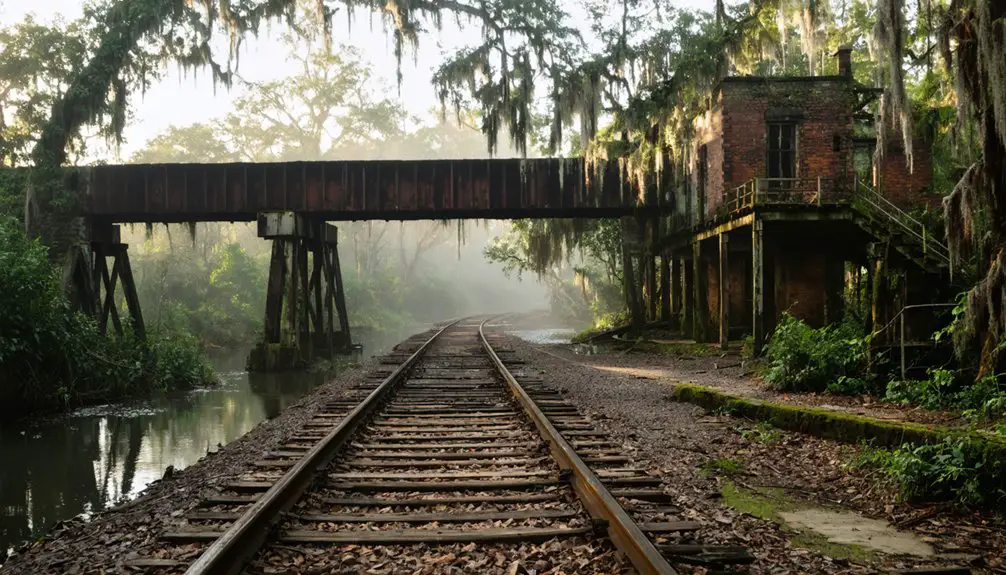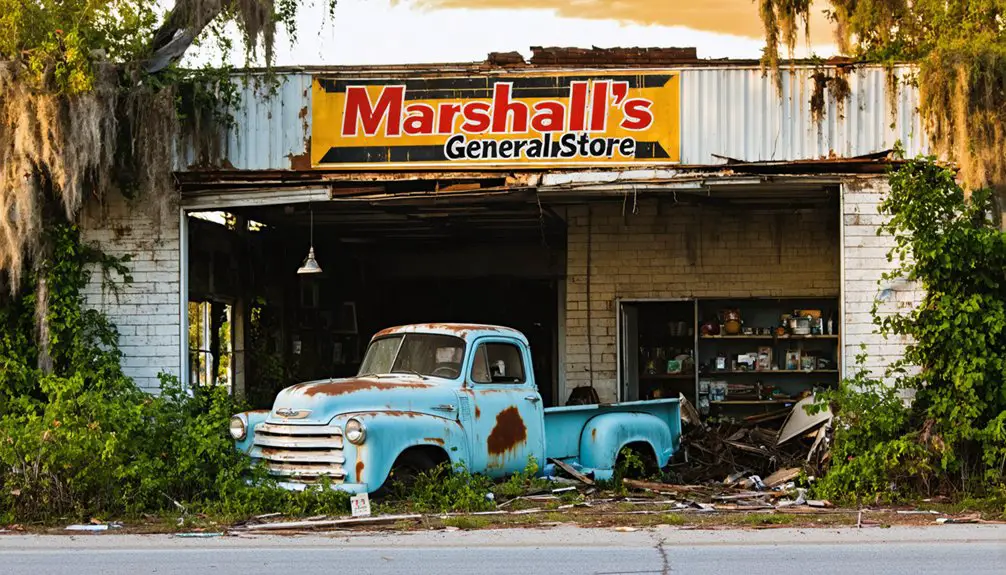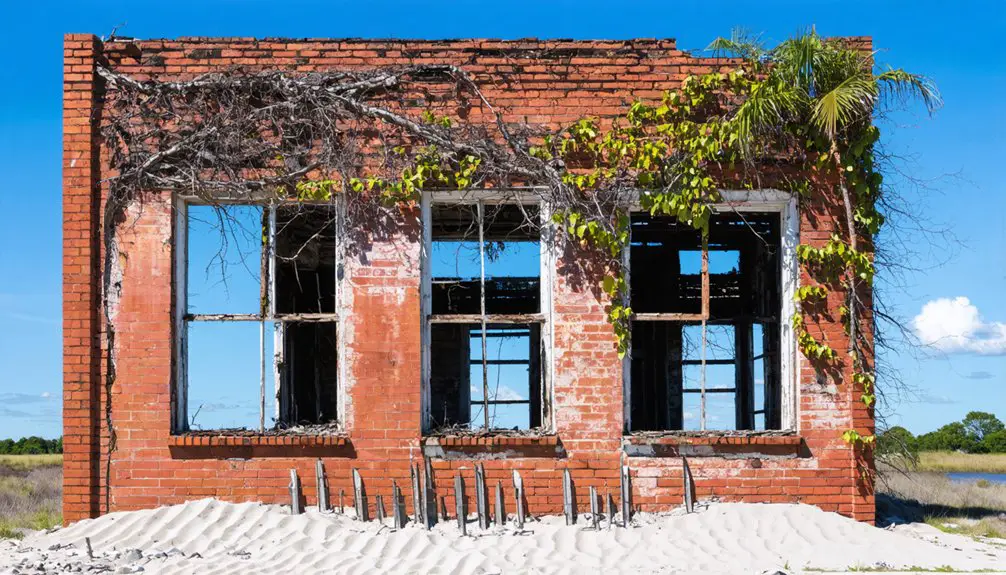You’ll find Pittsburg’s ghost town ruins in southern Polk County, Florida, about five miles north of Avon Park. This early 20th-century phosphate mining community once thrived with worker housing, stores, and processing facilities along three converging railway lines. Today, the abandoned settlement features brick foundations, remnants of rail infrastructure, and old water tanks amid pine flatwoods and mixed hardwood forests. The site’s crumbling structures tell a deeper story of Florida’s phosphate mining heritage.
Key Takeaways
- Pittsburg was a former phosphate mining town in Polk County, Florida, established in the early 20th century during Florida’s mining boom.
- The town was strategically located at the intersection of three railway corridors, facilitating phosphate transport across Florida’s transportation network.
- Archaeological remains include brick foundations, rail infrastructure, water tanks, and wells from the once-thriving mining community.
- The site is located at 27.65361°N and -81.50278°W, approximately five miles north of Avon Park in southern Polk County.
- Economic decline occurred as transportation routes bypassed the area, leading to business closures and eventual abandonment of the settlement.
A Lost Mining Town in Polk County
While many of Florida’s ghost towns have faded into obscurity, Pittsburg stands as a tribute to Polk County’s phosphate mining heritage.
You’ll find this abandoned town’s remnants nestled in an area that once buzzed with industrial activity during the early 20th century. Like other ghost town legends of Florida’s mining era, Pittsburg emerged following the discovery of valuable phosphate deposits, becoming a crucial hub for extraction operations.
The mining community dynamics revolved around the American phosphate industry’s boom, with the town featuring worker housing, stores, and community facilities. Much like Pittsburgh, Pennsylvania’s natural resource abundance enabled the town to thrive during its peak industrial years. Like many mining communities of the era, half the workers lived in company-provided housing that kept them tethered to the mining operation.
You can trace Pittsburg’s development alongside nearby mining communities like Brewster, as companies built these settlements to support their phosphate operations. The town’s infrastructure mirrored the standard company town model, designed to sustain a workforce dedicated to phosphate extraction and processing.
Geographic Location and Landscape
You’ll find the ghost town of Pittsburg situated among gently rolling terrain typical of Florida’s rural interior, where native pine and oak forests have reclaimed the abandoned settlement.
Rail lines once connected this remote location to nearby commercial centers, though today only scattered traces remain amid the natural vegetation. The site’s phosphate operations left behind open mining pits that dot the surrounding landscape.
The site’s modest elevation changes and sandy soil composition reflect the region’s characteristic landscape, shaped by historical land use patterns and subsequent environmental restoration. Similar to how desert sands infiltrate the buildings of Kolmanskop, natural vegetation has steadily overtaken Pittsburg’s remaining structures.
Elevation and Terrain Features
Situated in Hernando County’s gentle topography, Pittsburg’s terrain exhibits the characteristic flat to rolling landscape of central Florida, with elevations typically ranging between 20 and 150 feet above sea level.
Elevation analysis reveals a landscape once dominated by pine flatwoods and mixed hardwood forests, with terrain mapping showing scattered ponds that served the town’s logging operations.
You’ll find the ghost town’s foundations spread across undulating sandy-loam soil, typical of Florida’s Gulf Coast inland zones.
The site’s modest slopes and drainage patterns influenced the placement of sawmills near water sources, where logs could be easily transported. The old mill pond area along the river provided essential water access for the town’s lumber industry.
Similar to Fort Dade’s deteriorating infrastructure, much of Pittsburg’s original terrain features have eroded over time.
Today, nature reclaims the terrain as vegetation overtakes the brick and wooden remnants, gradually returning the landscape to its native ecosystem state.
Regional Position in Florida
Beyond the local terrain features lies Pittsburg’s distinct position within Florida’s heartland. The town shares historical similarities with ghost town settlements in Lake County.
You’ll find this ghost town situated at 27.65361°N and -81.50278°W in southern Polk County, roughly five miles north of Avon Park. The community’s cultural heritage reflects its namesake Pittsburgh, Pennsylvania, suggesting industrial roots that shaped its development. To avoid confusion with similar place names, historians often include Florida in reference materials as a place name disambiguation.
As an unincorporated community, Pittsburg exists within a landscape typical of inland Florida, where community dynamics once centered around phosphate mining operations.
You’re surrounded by mixed hardwood forests, pine flatwoods, and scrubland that support native wildlife. While the town itself may be quiet now, its strategic location near the Polk-Highlands County border positioned it perfectly for resource extraction during its heyday, though modern transportation networks have largely bypassed this historic settlement.
Railway and Mining Sites
Three distinct railway corridors once converged at Pittsburg’s mining sites, forming essential transportation arteries through the pine forests and wetlands of central Florida.
You’ll find these railway connections strategically positioned amid flat terrain, linking phosphate mining operations to the broader Florida East Coast Railway network.
The surrounding landscape, characterized by cypress swamps and seasonal waterways, influenced both rail routing and mining activities. Engineers had to adapt rail beds for stability across wetland areas while facilitating efficient mineral extraction and transport.
Today, nature has largely reclaimed these industrial sites, with abandoned tracks and scattered mining equipment slowly disappearing beneath vegetation.
The railway and mining remnants you can still discover tell the story of Pittsburg’s role in Florida’s resource extraction history.
Old railroad markers remain visible along the overgrown pathways, providing tangible evidence of the area’s industrial past.
Following the pattern of other Class II railroad operations in Florida, these rail corridors were crucial for transporting raw materials to processing facilities.
The Rise of Phosphate Mining
When prospectors discovered substantial phosphate deposits in Florida’s central region during the late 1800s, they sparked an industrial revolution that would transform the state’s landscape and economy.
By 1886, the first formal mining operation launched near Hawthorne, quickly expanding to ground and river pebble mining. You’ll find that phosphate extraction drew significant investment from Jacksonville and Philadelphia capitalists, who consolidated vast tracts of land for mining operations.
The industry’s rapid growth came at a considerable human cost. Workers, mainly Black laborers, endured harsh conditions in wooden shacks near the mines, battling diseases like malaria while working in the pits.
The Bone Valley Formation held immense wealth – over 317 million long tons of recoverable phosphate in the Fort Meade quadrangle alone – driving the region’s economic transformation despite the social and environmental toll.
Railroad Legacy and Transportation Hub

As Florida’s phosphate industry flourished in the late 19th century, Pittsburg emerged as an essential railroad hub connecting the state’s mining regions to broader markets. The town’s strategic location amid railroad expansion made it a vital link in Florida’s growing transportation grid, with tracks extending southward to Miami and northward along the Eastern Seaboard.
You’ll find that Pittsburg’s transportation dynamics revolved around multiple rail sidings and spurs, where freight handlers and yard workers transferred phosphate between trains. The Florida East Coast Railway and other major lines established maintenance yards and transit facilities, creating a bustling center of commerce.
While passenger service remained secondary to freight, the rail infrastructure supported community mobility until the mid-20th century, when highway development and declining mining operations led to Pittsburg’s eventual abandonment.
Industrial Connections to Pittsburgh, Pennsylvania
You’ll find the naming connection between Pittsburg, Florida and Pittsburgh, Pennsylvania reflects the latter’s dominant position as America’s “Steel City” during the industrial age.
The Florida settlement’s founders chose the similar name to evoke industrial progress and prosperity, though they dropped the ‘h’ that Pennsylvania’s Pittsburgh had restored to its name in 1911.
While Pittsburgh, Pennsylvania built its empire on steel manufacturing and mining operations, Pittsburg, Florida emerged as a mining town with parallel aspirations for industrial growth, though on a much smaller scale.
Steel City Naming Legacy
Although many ghost towns share names with prominent cities, Pittsburg, Florida’s direct connection to Pittsburgh, Pennsylvania stems from a deliberate effort to capture the industrial prestige of the “Steel City.”
The Florida town’s founders chose this name to evoke Pittsburgh’s renowned steel manufacturing legacy, which had transformed Pennsylvania’s industrial center into a symbol of American industrial might by the late 1800s.
You’ll find that this naming strategy reflected broader economic aspirations, as towns across America adopted names of industrial powerhouses to attract workers and investment.
The industrial symbolism of Pittsburgh, with its 446 bridges and massive steel output that peaked during WWII, represented the kind of growth and prosperity that developing communities sought to achieve.
This practice demonstrates how Pittsburgh’s reputation extended far beyond Pennsylvania’s borders.
Mining Town Parallel Growth
While Pittsburgh, Pennsylvania’s rise to industrial prominence centered on steel production, the city’s success fundamentally relied on the surrounding coal mining towns that supplied essential coke for blast furnaces.
You’ll find striking parallels between Pennsylvania’s coal communities and Florida’s mining settlements in their mining community dynamics. Both regions developed company-owned towns like Nemacolin, PA, and Brewster, FL, where mining companies provided extensive infrastructure including housing, schools, and stores.
The labor force evolution in these areas shared similar patterns, with immigrant workers drawn to mining opportunities. These industrial communities thrived through careful planning that prioritized proximity to transportation networks and processing centers.
When mines became unprofitable, both Pennsylvania and Florida towns faced similar fates of decline and eventual abandonment.
Economic Decline and Abandonment

Despite its early promise as a resource-based settlement, Pittsburg, Florida experienced a devastating economic decline that ultimately led to its abandonment.
The town’s economic resilience was severely tested as major transportation routes bypassed the community, cutting off crucial trade connections and market access. You’ll find that this isolation, combined with the decline of timber and agricultural industries, triggered a chain reaction of business closures and population migration to urban centers.
The town’s fate was sealed when competition from larger, better-connected cities diminished its economic relevance. Without a strong industrial base like its Pennsylvania namesake, Pittsburg couldn’t sustain itself.
The exodus of residents weakened the local tax base, leading to deteriorating infrastructure and public services until the community fundamentally ceased to exist.
Archaeological Remnants and Structures
Today’s archaeological surveys of Pittsburg reveal a rich tapestry of structural remnants that paint a picture of its once-thriving community.
You’ll find building foundations made of brick and stone, while derelict stairwells hint at the town’s architectural heritage from the late 19th to early 20th centuries.
The archaeological findings include traces of crucial transportation infrastructure, with partially buried rail lines and remnants of what might’ve been a locomotive roundhouse.
You can spot brick wells and water tanks that once served both the steam engines and local cattle operations.
These discoveries are complemented by evidence of early logging roads and tram lines that connected mills to trading centers, showcasing Pittsburg’s former role as an industrial hub in Florida’s economic landscape.
Impact on Local Development

After Pittsburg’s decline, its ghost town status triggered a cascade of developmental challenges that continue to shape the region.
You’ll find that community sentiment played a significant role in resisting commercial expansion, as locals prioritized preserving the area’s existing character over economic growth. This redevelopment resistance, combined with deteriorating infrastructure and declining property values, has created ongoing challenges for revitalization efforts.
- Infrastructure deterioration led to increased maintenance costs without community benefits
- Property values stagnated, deterring new investor interest in the area
- Local opposition highlighted tensions between preservation and modernization
- Reduced population caused decline in essential services and spending
- Environmental concerns emerged from abandoned properties and vacant lots
The impact rippled through various sectors, affecting everything from real estate markets to public services, while highlighting the delicate balance between progress and preservation.
Historical Significance in Florida’s Mining Era
Pittsburg emerged as an essential link in Florida’s phosphate mining boom during the early 20th century, marking a stark contrast to its current abandoned state.
As a thriving mining community in Florida’s Bone Valley region, you’d have found Pittsburg strategically positioned along railway lines, facilitating the transport of phosphate that helped establish Florida as a leading U.S. producer.
The town’s infrastructure included processing plants, extraction sites, and company-built homes that supported the burgeoning phosphate industry.
Today, you’ll find remnants of this industrial heritage scattered across the landscape – rusting equipment, building foundations, and railroad access points.
These artifacts serve as cultural heritage markers, telling the story of Florida’s resource-dependent towns and their essential role in the state’s agricultural and economic development.
Frequently Asked Questions
Are There Any Surviving Photographs of Pittsburg During Its Active Mining Years?
Like a needle in a haystack, you won’t find any confirmed historical photography of the town’s mining years. Mining archives haven’t yielded surviving photos, though some may exist in undiscovered private collections.
What Was the Peak Population of Pittsburg During Its Most Prosperous Period?
You won’t find exact Pittsburg demographics documented in mainstream records, but based on comparable mining boom towns of that era, it likely peaked at several hundred residents, possibly up to 700.
Were There Any Schools or Churches Established in Pittsburg?
You won’t find verified records of Pittsburg education or religion in historical documents. There’s no concrete evidence that any schools or churches were established in this ghost town.
Did Any Notable Historical Figures or Events Originate From Pittsburg?
You won’t find any famous residents or significant historical events documented from this location – archival records and historical accounts don’t reveal any notable figures or landmark occurrences worth mentioning.
What Happened to the Residents When the Town Was Abandoned?
You’ll find limited records of resident memories, but most likely they relocated to nearby towns seeking jobs and housing, much like other ghost towns’ residents who were forced to start anew.
References
- https://www.geotab.com/ghost-towns/
- https://www.youtube.com/watch?v=qORyGmeG7HM
- http://www.gribblenation.org/2018/06/ghost-town-tuesday-mannfield-fl-and.html
- https://en.wikipedia.org/wiki/List_of_ghost_towns_in_Florida
- https://en.wikipedia.org/wiki/Pittsburg
- https://pittsburghquarterly.com/articles/a-very-brief-history-of-pittsburgh/
- https://newsinteractive.post-gazette.com/coal-towns/
- https://en.wikipedia.org/wiki/Pittsburgh
- http://www.gribblenation.org/2018/09/ghost-town-tuesday-brewster-florida.html
- https://www.idahogeology.org/pub/Staff_Reports/2010/S-10-7.pdf



